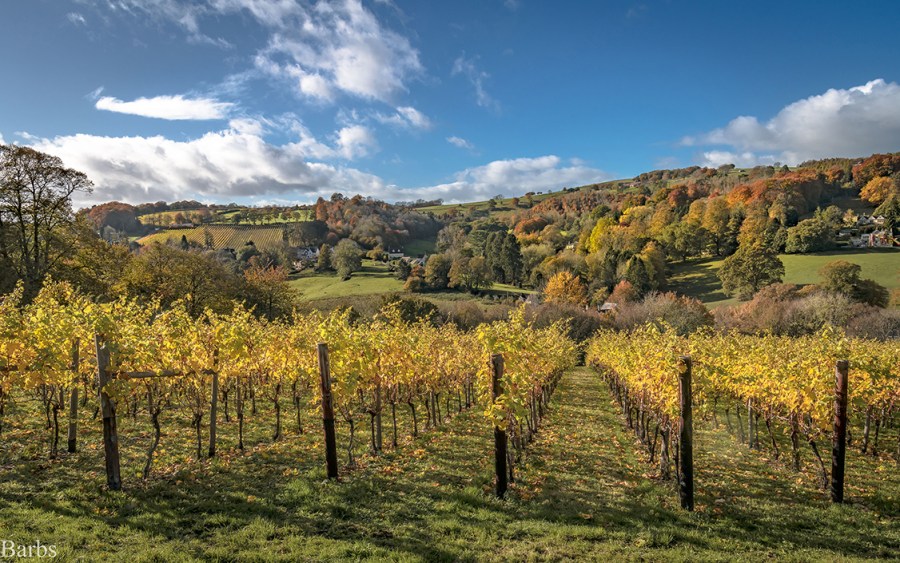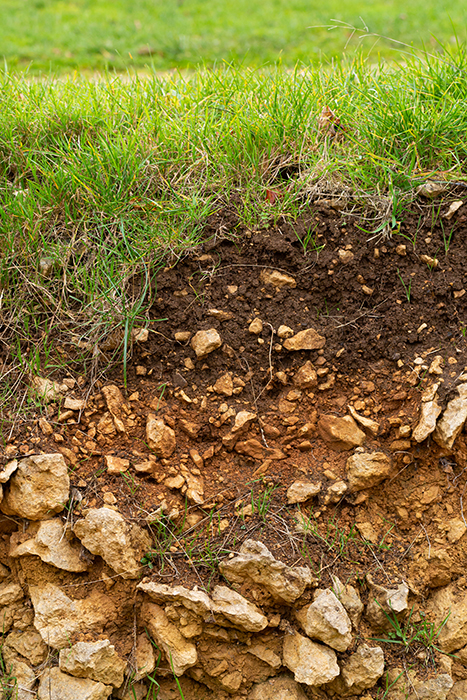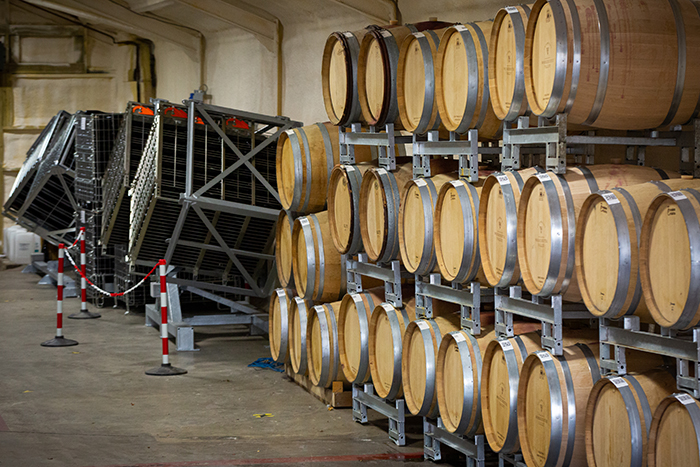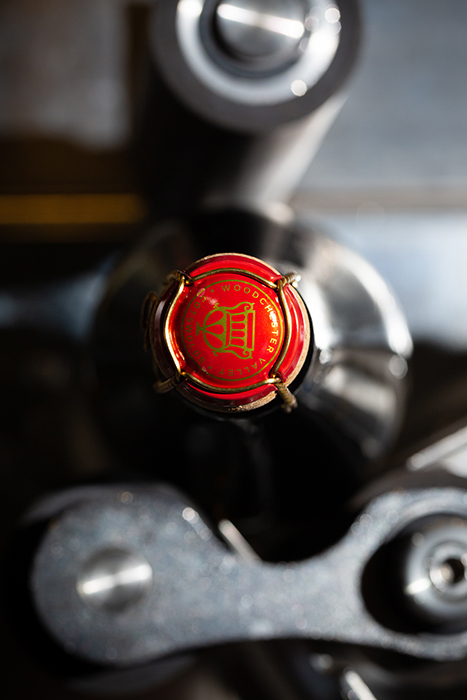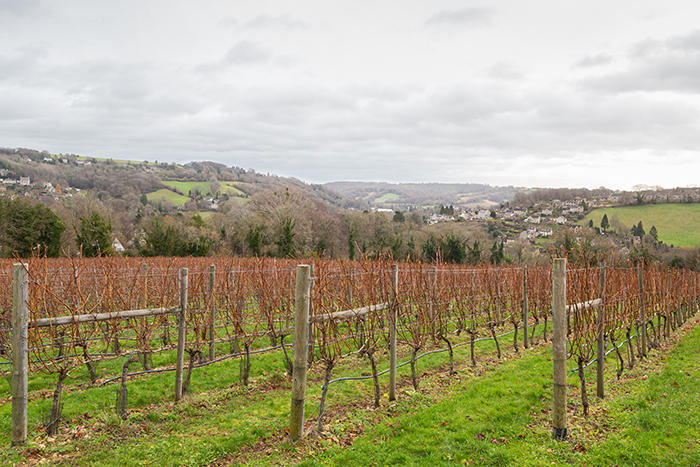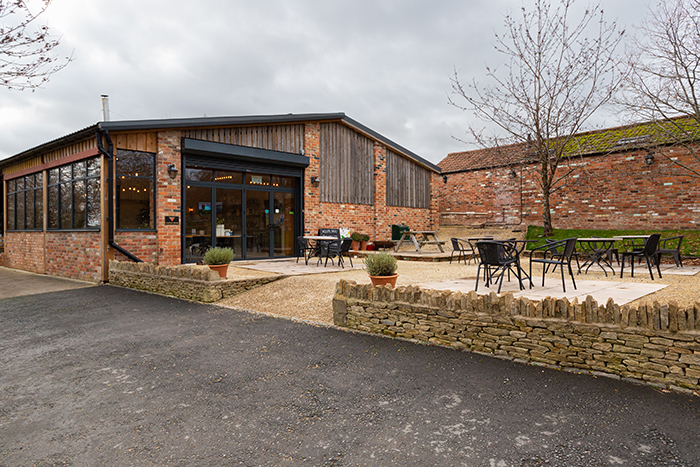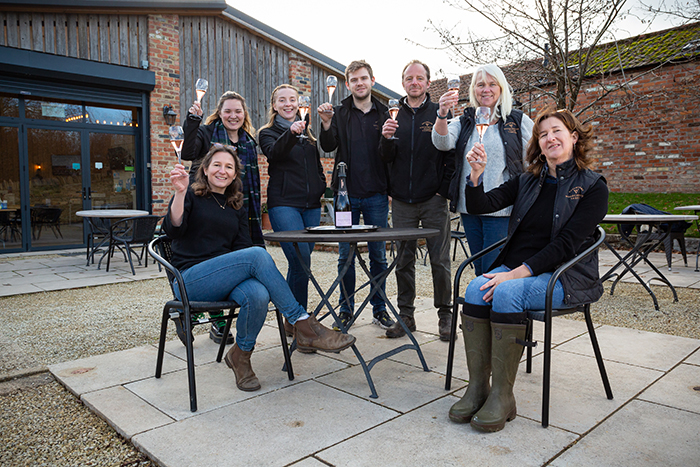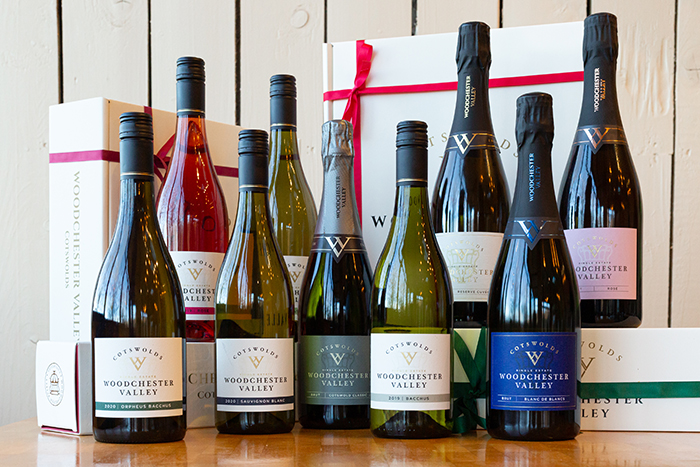Imagine steep slopes, drystone walls, wooded valleys and fast running streams and you will be picturing the scenic setting of Woodchester Valley Vineyards, in the South Cotswolds Area of Natural Beauty, where their three vineyards – Woodchester, Amberley and Stonehouse are planted. Vineyard discovers a site steeped in history, nurtured by the Shiner family, whose ethos is single estate, hand crafted wines which reflect a sense of time and place.
“The Domesday Book of 1086 records vineyards at ‘Stanhus’ – near our Stonehouse vineyard,” explained Fiona Shiner, Vineyard Manager and Co-owner of Woodchester Valley Vineyards. “In the 12th century, the historian William of Malmsbury wrote very flatteringly of the abundant vineyards of Gloucestershire: ‘no other county in England has so many or so good vineyards as this, for either the fertility or sweetness of the grape’.” Fiona added.
A family business
Woodchester Valley Vineyard was planted with its first trial site, of an acre, in 2007 and the first wines were made in 2010. However, a career change from solicitor to ‘vigneron’ was not on Fiona’s radar. “Had anyone told me 20 years ago, as we were returning to the UK after a 17-year stint in Hong Kong with a young family, that I would plant a vineyard from scratch and be running a wine business, I would have laughed out loud,” smiled Fiona.
“I have always been interested in wine and with my mother-in-law Mary, often speculated whether the Romans grew grapes on the steep fields around our house, where her rare breed sheep grazed, as Woodchester is home to the Orpheus Roman pavement. In 2005 the UK wine industry was looking interesting and with the children growing up, I was looking to go back to work. Law beckoned – but was finally out voted by the more tempting prospect of planting a vineyard on the limestone soils of our sheep fields.
“I qualified as a solicitor in the UK and quickly moved to do international tax and trust planning at a multinational firm in Hong Kong – and this experience has been extremely helpful to navigate the rules and regulations which apply to planting a vineyard and setting up a winery,” Fiona added.
Woodchester is very much a family-owned business. Owned by Niall and Fiona Shiner, Fiona runs the business and manages the vineyards at Woodchester, other family members include Fiona’s daughter Chloe, who is a key member of the management and finance team. “Chloe is a chartered accountant by training. In 2017 she was looking to move out of one of the ‘big four’ accountancy firms to join a start-up – and Woodchester Valley fitted the bill – it was very timely.” Fiona’s soon to be son-in-law, Greg, signed up for a vineyard apprenticeship after helping with the 2020 harvest. “A former quantity surveyor Greg is also our sustainability coordinator, as his first degree was environmentally focussed,” explained Fiona. Fiona’s sister-in-law, Gail, has been running the holiday accommodation since the outset. “Gail’s daughter, Emily, is currently working full time in her gap year in our cellar door shop and our tasting room. Cameo appearances are made by other family members during the busy season and for harvest!” Fiona added.
The team is completed with non-family members. “These include our talented head winemaker, Jeremy Mount, who has been making award-winning wines from the very first vintage processed through our winery. We are indebted to the expertise of Susan McCraith, a Master of Wine who advises on a consultancy basis. We also have a dedicated and very hard-working vineyard crew who have been with us for many years. They have a great sense of what is needed to produce quality fruit and work hard to make that happen.
“Our sales team have a good mix of retail and hospitality experience. Our shop staff and tour hosts are all WSET qualified with a passion for wine which they love to share with our customers, in an informative but approachable way. Our accommodation team are dedicated to excellent customer service and go beyond the necessary to ensure our guests have a great experience when staying with us. Our reviews are a credit to both teams. We are a close-knit team – all very hands on,” smiled Fiona.
The vineyards
Woodchester Valley Vineyards has three sites around the Stroud Valleys – Woodchester, Amberley and Stonehouse. They are predominantly south facing and planted on the limestone soils of the Cotswolds AONB. “The Cotswold brash has a shallow layer of topsoil, typically 20-40cm, over limestone and two of the vineyards, Woodchester and Amberley, have adjacent quarries,” explained Fiona. “The soils are free draining and very stony. The soils of our Stonehouse vineyard are more fertile with a higher clay content.
“All three vineyard sites are on steep slopes – I believe some of the steepest vineyard slopes in the UK – which rise quickly from 58m to 150m above sea level, at our highest point. All nestle below the higher topography of the surrounding hills which gives some protection from the prevailing westerly winds. Our fruit benefits from the intensity of the sun on the steep slopes which helps to ripen the grapes,” said Fiona.
The slopes help to mitigate against the risk of frost damage. “Although we have some areas at the very bottom of our slopes where the neighbouring woodlands cause frost issues, the majority of our vines have proved remarkably resilient to some very frosty springs and our Stonehouse site rarely suffers frost damage. The Normans – or whoever planted the vines recorded in the Domesday Book – knew what they were doing,” Fiona added.
“The trial acre in 2007 just happened to be one of the wettest summers on record. It was so wet that the local sewage treatment plant flooded and cut off much of the area’s fresh water supply. We were grateful for our slopes. Not an auspicious start. We only planted the one acre because as far as we knew, there had been no vineyards in this area for 2,000 years. However, we were very pleased with the results of the first vintage, so further plantings followed in 2011, 2012, 2013, 2015 and also in 2019.
“Establishing a vineyard and getting to know the potential of our sites has taken time. Just like grapes ripening for harvest, these things can’t be rushed, and, in our case, we have gradually rolled out our plantings, to better understand our sites. It has been a very interesting 14 years of getting to know what grows best and where – and we are learning all the time,” added Fiona.
Woodchester Valley Vineyards now has almost 23 hectares under vine, for both still and sparkling wines. “From the outset, I have been a firm believer in the potential to make quality still wines in the UK,” explained Fiona, “so we have a real focus on grape varieties for still wines such as Bacchus, Pinot Précoce, Ortega, Regent and Sauvignon Blanc. Pinot Noir is our largest planting; we have nine clones of Pinot Noir and six clones of Chardonnay, including Burgundian clones suitable for still wines. In years when the ripeness levels are good enough, we have the option to make a still Pinot Noir or Chardonnay… with our limestone soils – why would you not? Sparkling varieties also include Meunier, Pinot Gris, Pinot Blanc and Seyval Blanc. As we are on limestone and have high pH soils, we have a variety of rootstocks including SO4, Fercal and Binova,” added Fiona.
The vineyards are still relatively young, with vines at varying maturity, but over the last four years yields have averaged 6.10 tonnes per hectare. “We have had highs and lows of 3.3 tonnes in 2020 to 9.8 tonnes in 2018,” explained Fiona. “As a single estate vineyard, we have to wear what the harvest gives us, and we work very hard in the vineyard to make sure we maximise the potential for quality fruit each year with minimal losses to disease and wildlife. We all know what a roller coaster it can be to grow grapes in the UK, and it is important to be able to weather the ups and downs and factor them into your business plan,” advised Fiona.
When deciding when to harvest, Fiona and her team look for phenolic ripeness as well as target sugar and acidity levels depending on the style of wine to be made. “A characteristic of our sites is that our grapes tend to hold their acidity. In some years we reach our target sugars but have to wait for acidity to drop. So, keeping the fruit in good condition is critical to allow us to let it hang for optimum ripeness. More and more we are netting our later picked varieties – to prevent the wildlife enjoying them before we are ready to harvest! Wildlife is plentiful in our vineyards and in the words of one of our tour guides, Elizabeth, ‘it’s like there is a @wvv WhatsApp group which notifies the local birds, badgers, foxes, deer and squirrels that the grapes are ripe for the eating,’” said Fiona.
Harvest 2018 will be remembered as a fantastic year for most English vineyards, including Woodchester Valley. “We picked our Sauvignon Blanc grapes on 5 October at a natural 12% potential alcohol and 9.5 g/l TA, with a yield equivalent to 8.90 tonnes per hectare. The wine made from these grapes went on to win two international gold medals in the IWSC, 96 points, and Drinks Business Global Sauvignon Blanc Masters (one of ten golds) – the first English Sauvignon Blanc to achieve an international gold. We were pretty chuffed with this as planting Sauvignon Blanc was a bold move at the time,” smiled Fiona.
As for many vineyards harvest 2021 was more challenging. “We were all a bit nervous about harvest 2021. We knew it was a late year due to the cold spring and lacklustre summer, but flowering was surprisingly good down to a timely July heatwave – and the warm and sunny September and October really saved the day. Fortunately, the rains which plagued other regions missed us – it was like being under an umbrella with rain falling all around. We did not suffer from mildew and the grapes were clean and reached good sugar levels, and nearly all varieties performed well. Coming off a low yielding year in 2020, we made the decision early on that 2021 was not a year to experiment with new wines and after a late and long harvest ending on 2 November, we were rewarded with some fantastic fruit with intense flavours and aromas. Our yield came in at a nicely balanced seven tonnes per hectare,” added Fiona.
The winery
The winery was built in 2016 and has a capacity of 180 tonnes. “We adapted existing buildings on the farm at our Woodchester vineyard to remain in keeping with the environment. David Cowderoy from BevTech assisted on the design and the supply of the equipment for the winery. Jeremy joined us as winemaker in the summer of 2016, hot off the plane from his previous post at the Matua winery in New Zealand, just in time to help put the finishing touches to the winery, which was still a work in progress at the time. He transitioned from a winery making 30 million bottles a year to our first-year production of 30,000 bottles,” exclaimed Fiona.
“As a single estate vineyard and winery, we believe our wines should have an identity in the unique soils and aspects of our vineyards,” explained Jeremy. “We aim to make a diverse range of wines that are clean, well balanced and express the best characteristics of each of the different varieties.
“Our press has a hyper reductive function that helps to prevent any deterioration of the precursors of the flavour and aroma compounds for the still wines. We also have a positive nitrogen system to each tank that helps to prevent oxidation of any wines in tanks with ullage space. Other equipment includes a large cold store for storing grapes at five degrees pre-pressing,” Jeremy added.
“We currently have 67 barrels and are slowly building on this each year. They are bought either as reconditioned or new from French coopers. Currently for the still wines they are used for the fermentation of Ortega and some Bacchus which goes into the white blend ‘Culver Hill’ and the ‘Orpheus’. Barrels are also used for fermenting as much of the sparkling base wines as possible, which include Chardonnay and Pinot Noir. We also use a combination of both new and reconditioned barrels for aging the red wines for at least 12 months each year,” said Jeremy.
The wines
Still wines are a very important part of the Woodchester Valley portfolio. “The stills were the first wines we released and the wines upon which we built our reputation and won our first awards,” explained Fiona. “They account for approximately 60% of our production each year and our range includes white, rosé and red wines. Bacchus is a big player and features in our single varietal Bacchus and Orpheus Bacchus and as part of our Culver Hill blend, with Ortega and Seyval Blanc. We produce two rosé wines (harvest permitting), a delicate Pinot Rosé and a fuller bodied red berried rosé made from Regent. Our cellar door exclusives include a Sauvignon Blanc, Atcombe Red and Pinot Noir,” continued Fiona.
“I think that the best kept secret in the English Wine industry at the moment is the potential for the still wines. When we started producing wine, very few of our customers had heard of Bacchus, let alone drunk or had the confidence to order a bottle of English Bacchus in a restaurant. All that has changed in the last five years,” said Fiona.
Each harvest is different and while we have a core range of wines we make every year, some wines, such as a Pinot Noir is only made in years when the fruit reaches the appropriate ripeness levels,” added Jeremy.
Woodchester Valley currently produces a range of four traditional method sparkling wines. “The first sparkling wines produced in our winery were released in 2018 with our Cotswold Classic and Rosé Brut, followed by our Reserve Cuvée and Blanc de Blancs in 2019 and 2020. We were particularly pleased with the triple silver medals recently awarded to our 2017 Reserve Cuvée by Decanter, IWSC and the Champagne and Sparkling Wine Awards,” smiled Fiona proudly.
“Our Cotswold Classic sparkling is a blend of Pinot Blanc and Seyval Blanc, it is our Cotswold adaptation of traditional method from non-traditional varieties. It is a more fruit forward sparkling wine which we release after 15-18 months on the lees,” said Jeremy. “We also produce a vermouth in collaboration with our friends at The Cotswolds Distillery, added Fiona.
“Our single estate wines have distinctive characteristics – the limestone soils bring a purity and freshness to the wines, that is often commented upon by our customers,” said Fiona.
“As the industry is growing fast, we need to keep a focus on quality, and we are very lucky to have the wonderful resources at Plumpton College – which is training the future of the English Wine Industry,” added Fiona.
Routes to market
Woodchester Valley focusses strongly on retail with direct sales from the cellar door shop. “Our ‘Cellar Door Shop’ is a converted 19th century munitions factory on the busy A46 between two of our vineyards. We also have a tasting room adjacent to the winery on our Woodchester farm – which has far-reaching views across the valley. We are building up our online business.
“We also sell direct to local trade accounts in the Cotswolds and surrounding areas focusing on independents, delis, farm shops and restaurants with a local food and drink emphasis. We enjoy working with Thorman Hunt who distribute our core range of still wines outside of the Cotswolds and Oxfordshire, including London,” added Fiona. “But we do not export… we simply don’t have the volume.”
Wine tourism
“Whilst the focus is on wine production at Woodchester, the Cotswolds is a growing tourist destination and we get lots of visitors to the area,” explained Fiona. “There are not many vineyards in the Cotswolds AONB and fewer if any other wineries. It is scenic and people like to visit us. Earlier this year, Stroud was voted the best place to live in the UK.
“We also have holiday accommodation and the boom in UK wine tourism has been a big benefit for us – we have been phenomenally busy when we have been allowed to open. We have accommodation ranging from luxury guest barn rooms in the vineyard to self-catering properties which can sleep up to 12 people.
“A big recent phenomenon has been the arrival of the ‘DFLs’ (Down From London) –these are predominantly holiday visitors but increasingly people who live and work partly in London and partly from home. Stroud is only 1 ½ hours from London by train.
“Our tours and tastings are populated by a good mix of local residents, residents from the surrounding towns of Cheltenham, Bath and Bristol and tourists – UK and overseas when restrictions allow. The tastings, tours and accommodation all help to build our customer base,” continued Fiona.
Woodchester Valley offer regular tours and tastings throughout the year. “We have a busier schedule during the summer months. We offer a Classic Tour, a Sparkling Wine Tour, lunch tours with picnic hampers, fizz and chips tastings and even a wine tasting with a guided dog walk around the vineyard. We also offer more seasonal events, such as our Grand Christmas Tasting where you can taste the full range of our wines. We are fortunate to be close to the towns of Nailsworth and Stroud with plenty of restaurants – so we do not feel the need to have a restaurant onsite,” added Fiona.
Like many UK vineyards the pandemic resulted in an increase in their web-based sales. “Since the first lockdown was imposed in March 2020, we have seen a huge increase in online sales, 2020 was up 700% on 2019. In 2021 this has tailed off slightly but is still a very significant jump from pre-pandemic times. The combination of Covid-19 and Brexit, has meant a significant increase in both retail and local trade sales with a genuine interest by customers and the trade to buy local,” explained Fiona.
Collaboration is key at Woodchester Valley. “We work with lots of local businesses, from giving support to trade customers, cross marketing opportunities to offering corporate packages and events. We are popular with the local taxi firms who ferry our tour and tasting guests around and we always recommend our guests to visit the local pubs and restaurants as good refuelling stations before or after one of our tours,” said Fiona.

